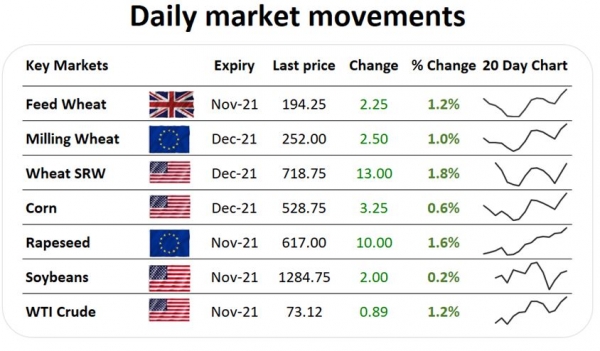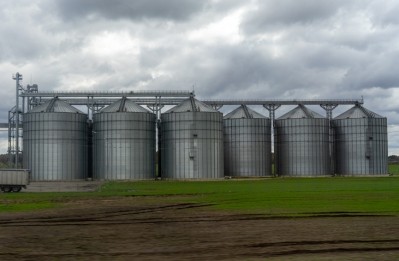Mixed prospects for EU crop yields, LATAM soybean meal price surge, strong demand for feed wheat

The EU JRC Mars bulletin indicated reduced yield forecasts for summer crops.
Although, all summer crop yield estimates remain above the five-year average, spring barley, grain maize, sunflower, and soybean yields were all trimmed from the August estimate, reported CRM Agri in a briefing on the bulletin.
“Downward revisions are mainly due to the negative impacts of continued hot and dry conditions in southern Europe. The yield forecasts for summer crops in western and central Europe remain positive, even benefiting from a slight upwards revision. The outlook is particularly positive for grain maize in France, Germany and Poland. Southern, and south-eastern European regions experienced continued dry conditions, often accompanied by hot temperatures, which negatively impacted the yield potentials of summer crops. This is particularly the case in large parts of Italy, Hungary, Romania, Bulgaria and Greece, as well as in southern Turkey,” according to the EU crop monitoring report.
The EU publication also showed mixed planting conditions for 2022 winter rapeseed crops. Wet weather caused delays in some parts of Germany, and the UK, but planting got off to a good start in Hungary and Ukraine, noted AHDB in its analysis of the outlook.
Bearish view on maize
Looking to maize production, CRM Agri analysts remained cautiously bearish toward global markets on Monday, with their weekly grain market opinion reporting easing US supply and demand, and a forecast record corn crop in Argentina.
In terms of the outlook for the Southern Hemisphere, those commodity market watchers cited data from Ag Rural, which is estimating that corn planting in Brazil has now reached 22%, only marginally behind the 23% in 2020. “Improved soil moisture conditions are providing better confidence for Brazilian first corn, following the recent drought decimated second Brazilian corn crop.”
But there is still risk potential. “Either Chinese purchasing or detrimental La Nina conditions would be a catalyst for a grain market bounce.”
Feed wheat tenders
Evaluating wheat prospects, on Tuesday, the AHDB team outlined how strong demand for wheat was being seen globally, with tenders for feed wheat issued by Jordan, Pakistan, and the Philippines. The combined volume of these tenders came to 984K tons.
Global wheat contracts rose on Wednesday, though, on supply worries, with rumors that Russia may raise their export tax further. “If export taxes rise, this could lead to further cuts in Russian exports, trimming global availability,” commented the AHDB experts.
Soybean meal price surge
S&P Global Platts reported on Thursday that South American FOB soybean meal basis levels had soared to record levels amid firm Indian demand and Hurricane Ida's effects on the US Gulf Coast's export facilities, with attribution to unnamed sources.
The demand for South American soybean meal, especially from Argentina, rose in early September because of Hurricane Ida's impacts on the US Gulf Coast, with multiple export facilities affected and some still not fully operational, according to those analysts. “The situation forced international buyers to shift their purchases from the US to other origins, with Argentina, the global top exporter of soybean meal, coming up as a natural source.”
In the meantime, the pace of soybean sales by farmers has been lower this marketing year compared with last in Argentina and Brazil, with possible impacts on crush operations and soybean meal production ahead, added S&P Global, citing sources.
US export data
Late yesterday, CRM Agri found that markets had gained across the board, with rapeseed continuing the upward streak.
Meanwhile, weekly US export data was broadly supportive for grains.
Wheat: "Although net sales of 355.9Kt for 2021/2022 were down 42% from the previous week, they are still up 1% from the prior 4-week average." Exports of 507.9KT were down 1% from the previous week, but up 2% from the prior 4-week average.
Corn: Net sales of 373Kt for 2021/2022 were primarily for Canada (135.8KT). "Exports of 485.8KT while still down year on year are showing signs of recovery, and up significantly from the 192Kt the week before."
Soybeans: Net sales of 902.9KT for 2021/2022 were primarily for China (624KT). "Exports of 274KT were perhaps a little disappointing, well below the same week last year (1.282Mt), but still up from last week."
The UK picture
In new analysis of UK grains production and uptake, AHDB said barley availability in 2020/21 increased year-on-year, with production up 1% to 8.12M tons and imports up 26% to 88K tons.
“Total domestic consumption rose 18% year-on-year, to 7.29M tons. This was mostly driven by increased animal feed demand. Barley ending stocks finished tighter than previous years too.”
Maize saw an increase in domestic consumption, up by 18% year-on-year, at 2.55M tons.
“This was mainly driven by a rise in animal feed demand. Maize imports were up 20% year-on-year to 2.86Mt, near 2018/19 levels.”
UK 2021/22 wheat production is expected to recover.
“With higher production, we may see animal feed ration inclusions rise from 2019/20. Barley inclusion is expected to remain strong should the discount to wheat hold, though it is important to remember the UK barley picture also looks tight. This year, there is also E10 ethanol demand to consider for feed wheat. So, supply and demand could remain tight for UK 2021/22 wheat.”














